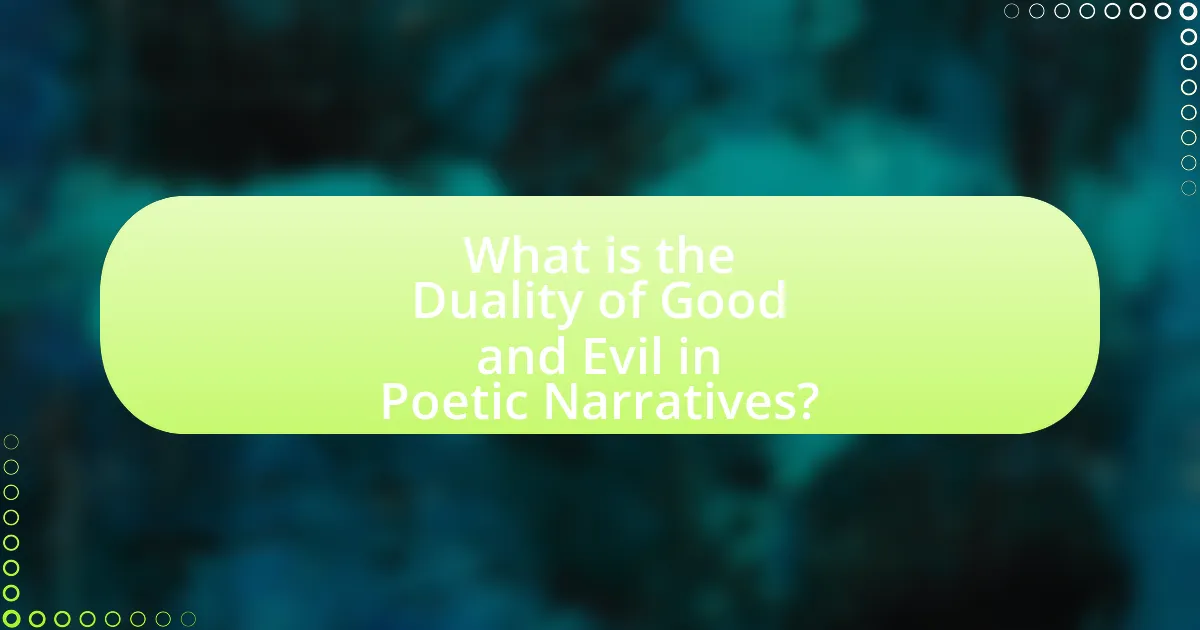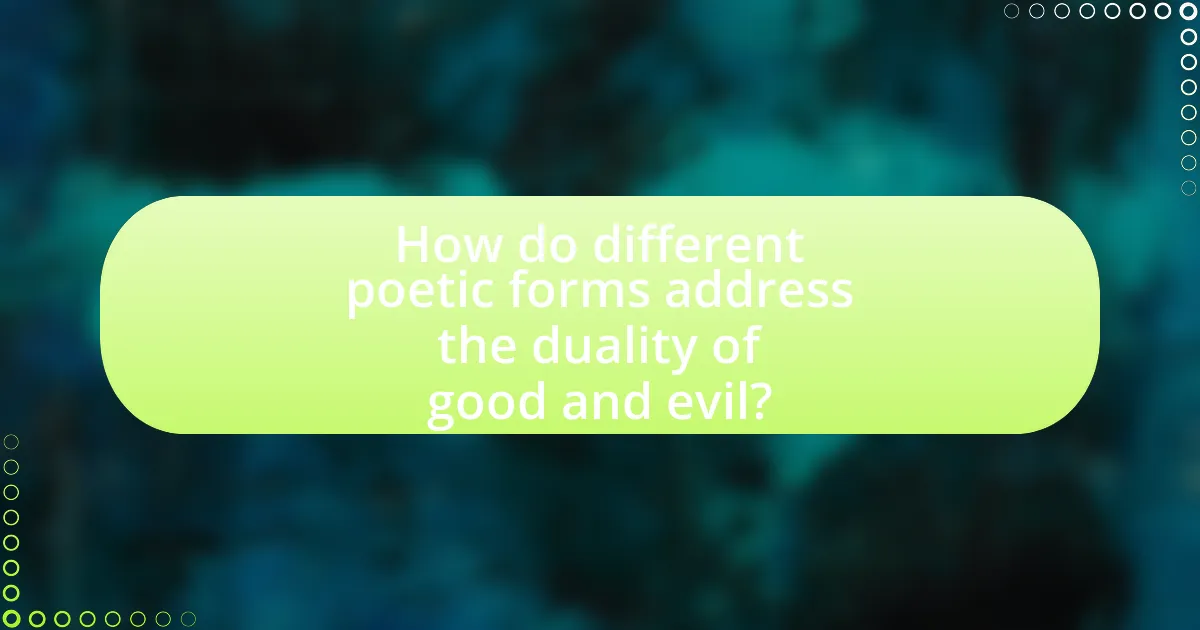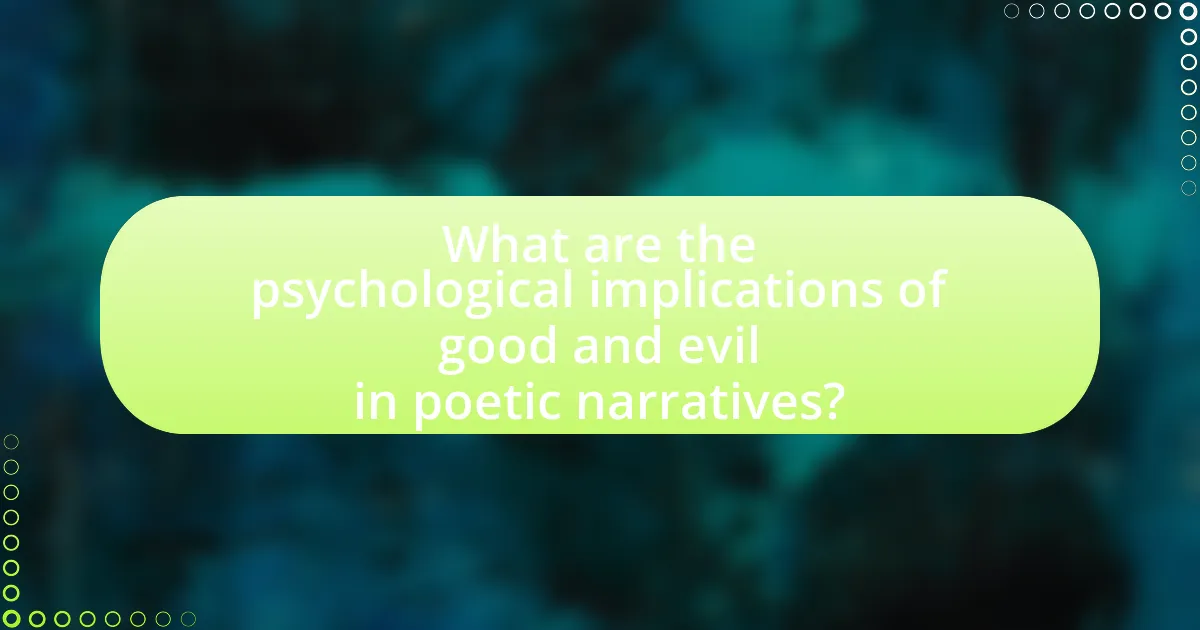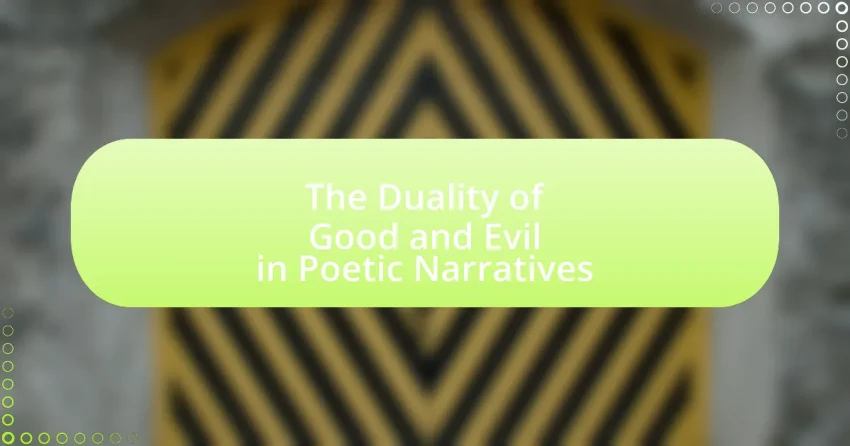The duality of good and evil in poetic narratives examines the contrasting moral forces that shape human experiences and ethical dilemmas. This article explores how poets represent this duality through characters, themes, and conflicts, highlighting the complexity of morality and the interdependence of good and evil. Key themes include the struggle between moral choices and the consequences of actions, while various poetic forms, such as sonnets and free verse, address these themes through symbolism and emotional resonance. The exploration of good and evil not only reflects societal values but also encourages readers to engage with their own moral beliefs and the psychological implications of these dualities.

What is the Duality of Good and Evil in Poetic Narratives?
The duality of good and evil in poetic narratives refers to the exploration of contrasting moral forces that shape human experience and ethical dilemmas. This duality often manifests through characters, themes, and conflicts that illustrate the complexity of morality, revealing how good and evil coexist and influence one another. For instance, in John Milton’s “Paradise Lost,” the character of Satan embodies rebellion against divine authority, while figures like Adam and Eve represent innocence and obedience, showcasing the tension between temptation and virtue. Such narratives often serve to provoke reflection on the nature of humanity, ethics, and the consequences of choices, emphasizing that good and evil are not absolute but rather interdependent forces within the human condition.
How is the concept of duality represented in poetry?
The concept of duality in poetry is represented through the juxtaposition of contrasting themes, such as good and evil, light and darkness, or love and hate. Poets often explore these opposing forces to highlight the complexity of human experience and moral ambiguity. For example, in John Milton’s “Paradise Lost,” the duality of good and evil is embodied in the characters of God and Satan, illustrating the struggle between divine order and rebellion. This representation allows readers to engage with the inherent conflicts within themselves and society, making the exploration of duality a central theme in poetic narratives.
What are the key themes associated with good and evil in poetic works?
Key themes associated with good and evil in poetic works include the struggle between moral choices, the nature of human existence, and the consequences of actions. Poets often explore the duality of good and evil through character conflicts, illustrating how individuals grapple with ethical dilemmas. For instance, in John Milton’s “Paradise Lost,” the character of Satan embodies rebellion against divine authority, representing evil, while figures like Adam and Eve symbolize innocence and the pursuit of goodness. This thematic exploration highlights the complexity of morality and the human condition, as seen in works from various literary traditions, where good and evil are not merely opposing forces but intertwined aspects of life.
How do poets use symbolism to convey duality?
Poets use symbolism to convey duality by employing contrasting images and motifs that represent opposing forces, such as good and evil. For instance, in John Milton’s “Paradise Lost,” light symbolizes divine goodness while darkness represents sin and chaos, illustrating the struggle between these dual aspects of existence. This use of symbolism allows poets to explore complex themes and evoke emotional responses, as seen in works like William Blake’s “Songs of Innocence and of Experience,” where the innocence of childhood is symbolized by lambs, contrasting with the predatory nature of adulthood represented by tigers. Such symbolic representations effectively communicate the inherent tensions and coexistence of dualities within human experience.
Why is the exploration of good and evil significant in poetry?
The exploration of good and evil is significant in poetry because it allows for a deep examination of human nature and moral dilemmas. Poetry often serves as a reflection of societal values and personal beliefs, enabling readers to confront complex ethical questions. For instance, works like John Milton’s “Paradise Lost” illustrate the struggle between divine authority and human free will, showcasing how these themes resonate across cultures and eras. This exploration fosters empathy and understanding, as it encourages readers to consider multiple perspectives on morality and the consequences of actions.
What insights can be gained from understanding this duality?
Understanding the duality of good and evil in poetic narratives reveals the complexity of human nature and moral ambiguity. This duality illustrates that characters often embody both traits, reflecting real-life struggles between ethical choices and personal desires. For instance, in John Milton’s “Paradise Lost,” the character of Satan exemplifies both charisma and malevolence, prompting readers to question the nature of heroism and villainy. Such insights encourage deeper engagement with moral dilemmas, fostering empathy and critical thinking about the consequences of actions in both literature and life.
How does this duality reflect human experience and morality?
The duality of good and evil reflects human experience and morality by illustrating the inherent conflict within individuals and societies. This duality manifests in the choices people make, highlighting the struggle between altruism and selfishness, which is a fundamental aspect of human nature. For instance, literary works often depict characters facing moral dilemmas that force them to confront their values, such as in Shakespeare’s “Macbeth,” where ambition leads to moral decay. This portrayal emphasizes that moral choices are rarely black and white, mirroring the complexities of real-life ethical decisions. The existence of good and evil in narratives serves as a framework for understanding human behavior, reinforcing the idea that morality is shaped by context, experience, and the consequences of one’s actions.

How do different poetic forms address the duality of good and evil?
Different poetic forms address the duality of good and evil by employing various structural and thematic techniques that highlight moral complexities. For instance, sonnets often juxtapose contrasting ideas within their strict rhyme schemes, allowing poets to explore the tension between virtue and vice, as seen in Shakespeare’s “Sonnet 146,” where the speaker grapples with the conflict between spiritual wealth and materialism. Similarly, free verse allows for a more fluid exploration of these themes, as poets can weave narratives that reflect the ambiguity of moral choices, exemplified in Allen Ginsberg’s “Howl,” which critiques societal norms and the darkness within humanity. Additionally, narrative poetry, such as Dante’s “Divine Comedy,” explicitly portrays the journey through sin and redemption, illustrating the consequences of good and evil actions. These forms collectively demonstrate how poetic structures can effectively convey the intricate relationship between good and evil, engaging readers in a deeper moral discourse.
What are the various poetic forms that explore this theme?
Various poetic forms that explore the theme of the duality of good and evil include sonnets, ballads, and free verse. Sonnets, particularly the Shakespearean and Petrarchan forms, often delve into moral dilemmas and the conflict between virtue and vice, using structured rhyme schemes to emphasize contrasts. Ballads, with their narrative style, frequently depict tales of heroism and villainy, illustrating the struggle between good and evil through storytelling. Free verse allows poets to express complex emotions and philosophical reflections on morality without the constraints of traditional forms, enabling a more nuanced exploration of the theme. These forms have been utilized by poets such as John Milton in “Paradise Lost,” which examines the fall of man and the nature of good and evil, showcasing the effectiveness of these structures in conveying the theme.
How does narrative poetry depict the struggle between good and evil?
Narrative poetry depicts the struggle between good and evil through character conflicts, moral dilemmas, and thematic contrasts. In works like Dante Alighieri’s “The Divine Comedy,” the journey through Hell, Purgatory, and Heaven illustrates the consequences of moral choices, showcasing the eternal battle between sin and redemption. Similarly, John Milton’s “Paradise Lost” presents the fall of man as a pivotal moment where the choices of Adam and Eve reflect the tension between obedience to divine will and the temptation of evil. These examples highlight how narrative poetry uses plot and character development to explore the complexities of morality, ultimately revealing the nuanced nature of good and evil.
What role does free verse play in expressing duality?
Free verse plays a crucial role in expressing duality by allowing poets to break free from traditional structures, thereby reflecting the complexity of opposing themes such as good and evil. This form of poetry enables the juxtaposition of contrasting ideas without the constraints of rhyme and meter, which can limit expression. For instance, poets like Walt Whitman and Allen Ginsberg utilize free verse to explore the multifaceted nature of human experience, capturing the tension between light and darkness, morality and immorality. The fluidity of free verse mirrors the unpredictable nature of duality, allowing for a more nuanced exploration of these themes.
How do historical contexts influence the portrayal of good and evil in poetry?
Historical contexts significantly influence the portrayal of good and evil in poetry by shaping the moral frameworks and societal values reflected in the works. For instance, during the Romantic period, poets like William Wordsworth emphasized individualism and nature, portraying good as a return to innocence and evil as societal corruption. In contrast, the Victorian era, marked by industrialization and social reform, saw poets like Alfred Lord Tennyson depict good as moral duty and evil as the consequences of neglecting social responsibilities. These shifts illustrate how historical events, such as wars, revolutions, and cultural movements, directly impact the thematic representations of good and evil in poetic narratives.
What examples illustrate the impact of cultural background on poetic narratives?
Cultural background significantly influences poetic narratives, as seen in works like “The Waste Land” by T.S. Eliot and “The Song of Solomon” by Toni Morrison. Eliot’s poem reflects the disillusionment of post-World War I Europe, incorporating diverse cultural references that highlight the fragmentation of modern identity. In contrast, Morrison’s narrative draws from African American folklore and history, exploring themes of heritage and identity, which shape the characters’ understanding of good and evil. These examples demonstrate how cultural contexts inform the themes, symbols, and emotional depth within poetry, illustrating the profound impact of cultural background on poetic expression.
How have societal changes shaped the themes of good and evil in poetry?
Societal changes have significantly shaped the themes of good and evil in poetry by reflecting evolving moral values and cultural contexts. For instance, during the Romantic period, poets like William Wordsworth and Samuel Taylor Coleridge emphasized individualism and nature, portraying good as a return to innocence and evil as societal corruption. In contrast, the Modernist movement, exemplified by T.S. Eliot, depicted a fragmented world where traditional notions of good and evil were questioned, reflecting the disillusionment following World War I. These shifts illustrate how poetry adapts to societal transformations, capturing the complexities of morality as influenced by historical events, social movements, and philosophical debates.

What are the psychological implications of good and evil in poetic narratives?
The psychological implications of good and evil in poetic narratives revolve around the exploration of moral dilemmas and the human condition. These narratives often serve as a reflection of internal conflicts, allowing readers to engage with their own values and beliefs. For instance, characters embodying good and evil can evoke empathy or revulsion, prompting introspection about one’s own moral compass. Research indicates that literature, including poetry, can enhance emotional intelligence by facilitating the understanding of complex moral situations (Mar et al., 2006, “Book Reading, Mindfulness, and Empathy,” Journal of Research in Personality). This engagement with good and evil in poetry not only fosters a deeper understanding of societal norms but also encourages personal growth through the examination of one’s own ethical stance.
How do poets use characters to embody good and evil?
Poets use characters to embody good and evil by creating distinct personas that represent moral extremes, often illustrating the conflict between these forces. For example, in John Milton’s “Paradise Lost,” characters like Satan embody evil through rebellion and ambition, while figures like Adam and Eve represent innocence and virtue. This duality allows poets to explore complex themes of morality, choice, and consequence, demonstrating how characters’ actions reflect broader ethical dilemmas. The portrayal of these characters serves as a vehicle for readers to engage with the philosophical questions surrounding good and evil, making the abstract concepts tangible and relatable.
What psychological theories can be applied to understand these characters?
Psychological theories such as Jungian psychology, Freudian psychoanalysis, and moral development theory can be applied to understand characters in the context of the duality of good and evil in poetic narratives. Jungian psychology emphasizes the concept of the shadow, representing the unconscious aspects of the personality, which can manifest as both good and evil traits in characters. Freudian psychoanalysis explores the conflict between the id, ego, and superego, illustrating how characters navigate their desires and moral constraints. Moral development theory, proposed by Lawrence Kohlberg, provides insight into how characters evolve in their understanding of right and wrong, reflecting the complexities of human morality. These theories collectively offer a framework for analyzing the psychological motivations and moral dilemmas faced by characters in poetic narratives.
How do character arcs reflect the duality of good and evil?
Character arcs reflect the duality of good and evil by illustrating the transformation of characters as they navigate moral complexities. These arcs often depict characters who start with clear moral alignments but undergo significant changes due to internal conflicts or external influences, showcasing the struggle between virtuous and malevolent impulses. For example, in classic literature, characters like Dr. Jekyll and Mr. Hyde exemplify this duality, as Jekyll’s transformation into Hyde represents the conflict between his good nature and his darker desires. This duality is further emphasized through the consequences of their choices, which often lead to redemption or downfall, reinforcing the idea that good and evil coexist within individuals.
What techniques do poets employ to evoke emotional responses related to duality?
Poets employ techniques such as juxtaposition, imagery, and symbolism to evoke emotional responses related to duality. Juxtaposition allows poets to place contrasting ideas side by side, highlighting the tension between good and evil, which can elicit strong emotional reactions from readers. For example, in John Milton’s “Paradise Lost,” the stark contrast between the heavenly and hellish realms intensifies the emotional weight of the narrative. Imagery engages the senses and creates vivid mental pictures that resonate with readers, making the abstract concepts of duality more tangible. Symbolism further deepens emotional responses by representing complex ideas through concrete images, such as light symbolizing good and darkness representing evil. These techniques collectively enhance the reader’s emotional engagement with the themes of duality in poetry.
How does imagery enhance the understanding of good and evil?
Imagery enhances the understanding of good and evil by creating vivid mental pictures that evoke emotional responses and clarify moral distinctions. Through descriptive language, poets can illustrate the stark contrasts between virtuous and malevolent characters, settings, and actions, making abstract concepts more tangible. For example, the use of light imagery often symbolizes goodness, while dark imagery represents evil, allowing readers to intuitively grasp these moral dichotomies. This technique is evident in works like John Milton’s “Paradise Lost,” where the imagery of heaven and hell serves to reinforce the themes of divine justice and rebellion. Such visual representations deepen the reader’s comprehension of the complexities surrounding good and evil, facilitating a more profound engagement with the narrative.
What role does tone play in shaping the reader’s perception of duality?
Tone significantly influences the reader’s perception of duality by establishing emotional resonance and guiding interpretation. In poetic narratives, a contrasting tone can highlight the complexities of good and evil, prompting readers to explore the nuances between these opposing forces. For instance, a somber tone may evoke empathy for a character embodying evil, while a lighthearted tone could complicate the perception of a seemingly good character, suggesting that duality exists within all individuals. This interplay of tone and duality encourages readers to reflect on moral ambiguity, as evidenced in works like Robert Louis Stevenson’s “Strange Case of Dr Jekyll and Mr Hyde,” where the tone shifts between horror and curiosity, shaping the reader’s understanding of the dual nature of humanity.
What practical insights can be drawn from the duality of good and evil in poetry?
The duality of good and evil in poetry reveals the complexity of human nature and moral ambiguity. This duality allows readers to explore the motivations behind actions, illustrating that good and evil often coexist within individuals and societies. For instance, in John Milton’s “Paradise Lost,” the character of Satan embodies both rebellion and charisma, prompting readers to question the nature of heroism and villainy. Such insights encourage critical thinking about ethical dilemmas and the consequences of choices, highlighting that moral judgments are rarely black and white. This exploration fosters empathy and understanding, as it reflects the multifaceted reality of human experiences.
